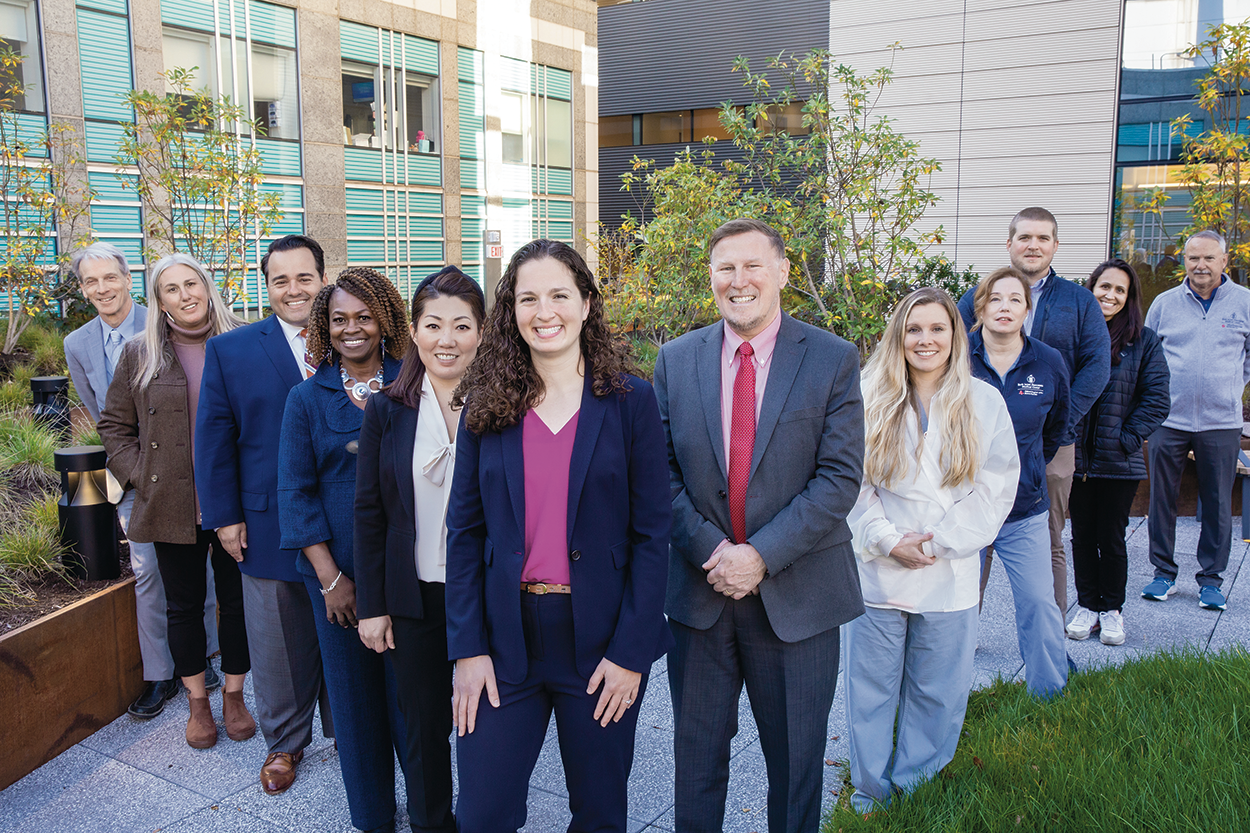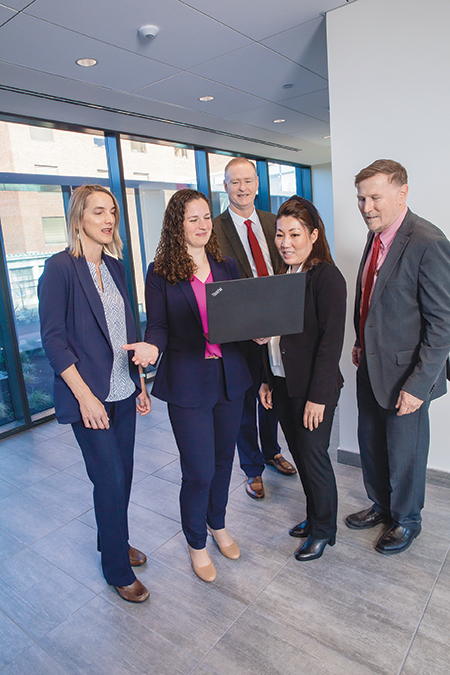BIDMC creates award-winning sustainability programs
A number of leading hospitals and health systems are taking meaningful action to reduce their carbon footprint and lessen the impact to their communities. In 2022, the Department of Health and Human Services called on hospitals, suppliers and other healthcare stakeholders to commit to achieving net zero greenhouse gas emissions by 2050 (with a 50% reduction by 2030). Representing over 650 hospitals and thousands of other stakeholders, 61 of the largest health systems and companies responded. And Beth Israel Deaconess Medical Center (BIDMC), a member hospital of HealthTrust and a teaching hospital in Boston, was one of them.

This was just the latest example of BIDMC’s long-held commitment to action on sustainability initiatives. The medical center has accomplished a number of remarkable achievements, and staff member Avery Palardy was recognized in 2022 with the HealthTrust Membership Recognition Award for Social Stewardship—Sustainability.
“We know that the healthcare industry is a significant contributor to greenhouse gas emissions that exacerbate climate change and air pollution and, as a result, disproportionately impact low-income and minority patient populations. To be leaders in healthcare, we believe it is vital to decrease our negative environmental impact quickly and efficiently with a focus on safety, quality and affordability,” says Palardy, Sustainability Program Manager at BIDMC. “We want to continue to be part of the solution, not the problem, and ensure that our services are protecting the communities that need us the most.”
Palardy was nominated for the award by Susan Ohlund, Account Director at HealthTrust. “When I thought of the Social Stewardship award, Avery and the work done at BIDMC in the area of sustainability came to mind,” she says. “I am proud of their accomplishments.”
Translating science into action
BIDMC’s sustainability journey started in 1998, when it was one of the first hospitals in the U.S. to remove mercury thermometers in partnership with Health Care Without Harm, an organization dedicated to transforming the health sector worldwide, so that it reduces its environmental footprint and becomes a community anchor for sustainability.

Grassroots efforts took hold from there, which led to the formation of the hospital’s first sustainability committee in 2008. The Capital Facilities and Engineering team introduced
energy conservation projects, established an automatic approval process for three-year ROI energy projects and pursued LEED certification for the design of a new inpatient building.
This culture of sustainability and the opportunity to put her academic background in environmental science to work is what attracted Palardy to the job when she joined BIDMC in early 2019. “Working at BIDMC is an opportunity to translate science into action. This position allows me to combine my expertise in climate change with my knowledge of business operations paving the way for more impactful change. There’s a wide range of outcomes that are possible at this moment based on how effective we are at mitigating our carbon emissions, and I wanted to be at the forefront of this necessary change in our behavior,” she says.
Operationalizing sustainability
Palardy leads the Sustainability team of volunteers and two full-time employees, which includes a senior data analyst who built the foundation for increasing transparency and standardization of the analytics for their programs and goals.
A Sustainability Steering committee, which evolved from the hospital’s first Sustainability committee in 2008, consists of volunteer representatives from necessary functional areas of the hospital. Subcommittees work on specific areas; for example, a Green Labs subcommittee focuses on sustainability in BIDMC’s research laboratories and clinical research to improve energy efficiency, reduce waste and increase diversion programs.
In 2021, the Sustainability Steering committee established strategic action plans for the first time for their cross-departmental goals in waste, transportation and engagement with support from senior leadership to ensure alignment with organizational priorities. Committee members work directly with the Sustainability department and their own departments to implement these plans. The Sustainability department is responsible for pushing forward the strategic direction, making sure projects stay on track, collaborating across departments, providing leadership and resource support, and tracking and analyzing key metrics.
“Success is achieved through a team effort and a commitment from people within different departments of the hospital,” adds Ohlund. “We know how busy hospital staff members are, and for people to take time to volunteer on various committees to achieve their sustainability objectives and initiatives speaks volumes.”
The ability to work across departments, and the collaboration between senior leaders, clinicians and other staff, is key to the success of the hospital’s sustainability program, explains Palardy. “Without buy-in across the organization, very little would be accomplished.”
Greening the supply chain
Scope 3 emissions—emissions from producing and transporting goods and services in the supply chain—account for more than 80% of healthcare emissions. Recognizing this, BIDMC is looking to its supply chain to reduce costs and align purchasing with sustainability goals. Palardy will be conducting an inventory of the hospital’s Scope 3 emissions to collect baseline data to inform their next steps in sustainable procurement.
As a member of Beth Israel Lahey Health, a relatively new health system, BIDMC is in the process of standardizing supplier contracts as an important first step. By integrating sustainability language into contracts, BIDMC and Beth Israel Lahey Health can leverage their buying power to encourage transparency from manufacturers on the environmental and health impact of their products and the services they offer.
Single-use device reprocessing is another area where BIDMC has seen environmental benefits, as well as financial savings. “We partner with third-party vendors to create a program focused on circularity; they assist with establishing collections at our facility, reprocess and test the devices to prove they are as good as those originally manufactured, and then we can purchase the devices back at a discounted rate,” says Palardy.
Building “healthy” facilities
BIDMC’s new inpatient building, scheduled to open in early 2023, has been awarded LEED Gold Certification. LEED is a globally recognized certification system for designing sustainable, cost-effective and health-promoting buildings, administered by the Green Building Certification Institute. To achieve certification, new buildings (or retrofitted existing buildings) must meet strict requirements in areas such as energy, water, waste and materials.
Features of the LEED-certified building include:
- Reduced energy use by 39% compared to the region’s average hospital and by over 50% compared to BIDMC’s existing campus average
- Improved indoor environmental quality through the use of low emitting materials, such as low VOC paint and coatings, adhesive and sealants, and flooring—with access to quality views in most regularly occupied spaces and the use of glare-control devices
- Limited use of materials and furnishings that contain chemicals of concern, such as antimicrobials, flame retardants and vinyl
Reducing food environmental impact
BIDMC also committed to the Cool Food Pledge, an initiative from the World Resources Institute that asks members to achieve a 25% reduction in the greenhouse gas emissions associated with the food they serve by 2030.
With food production accounting for a quarter of global greenhouse gas emissions—the majority of which comes from animal-based foods—the Cool Food Pledge encourages organizations to transition to plant-based foods.
By offering more plant-based meals in its cafeterias and by improving meal forecasting to reduce food waste, BIDMC has already cut food-related emissions by 27%.
Reducing emissions from anesthetic gases

Inhaled anesthetic gases, such as desflurane, sevoflurane, isoflurane and nitrous oxide, significantly contribute to the healthcare industry’s greenhouse gas emissions. But not all anesthetic gases have the same impact. For example, desflurane has about 26 times the global warming potential of sevoflurane. It is also over 2,500 times more warming than carbon dioxide.
BIDMC first reduced its use of desflurane by educating and encouraging anesthesiologists to use less of it or use an alternative, such as sevoflurane. Then in 2020, after BIDMC analyzed the use of desflurane from a patient safety perspective and found no difference in desflurane over sevoflurane, the hospital stopped purchasing desflurane completely.
These actions have helped BIDMC reduce its greenhouse gas emissions associated with volatile anesthetic gases by 82% (since 2016).
The focus now is on nitrous oxide, another significant contributor to greenhouse gases. A team of anesthesiologists on BIDMC’s Greening the OR subcommittee are advocating for alternative practices when possible, such as the use of local anesthetics, low-flow techniques, and a shift in the storage of nitrous oxide from central to local storage to reduce leaks and wasted gas.
“We are evaluating what it will take to achieve decarbonization and have committed to reducing our carbon footprint 50% by 2030 and achieving net zero by 2050,” says Palardy. “We recognize the need to rethink our operations and are moving forward to make our goals the reality.”
Share your sustainability best practices. Visit the HealthTrust Huddle online community and click ‘request to join.’
Read more about the other 2022 HealthTrust Member Recognition awards recipients in five other categories.
Share Email Facilities Management, Member Awards, Operations, Q1 2023




